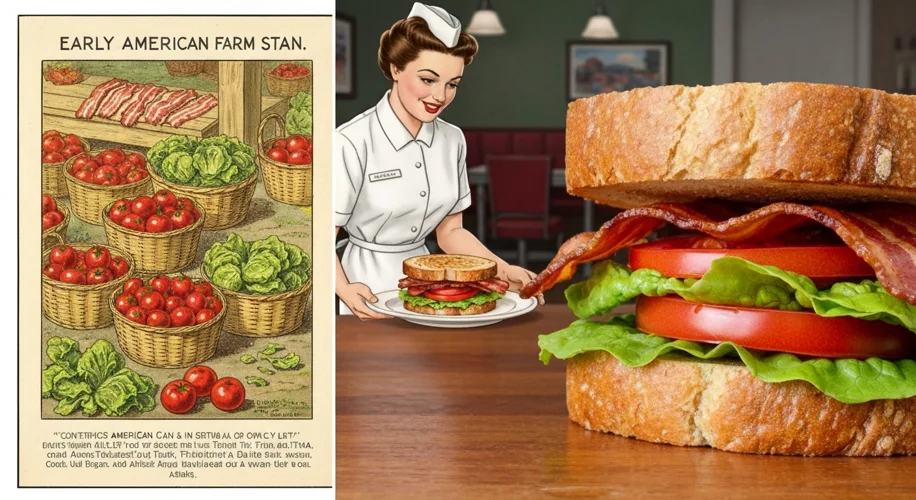In the pantheon of American culinary icons, few sandwiches reign as supreme and universally beloved as the BLT. It’s a simple masterpiece: the salty crisp of bacon, the cool crunch of lettuce, and the sweet, acidic burst of ripe tomato, all nestled between two slices of toasted bread. But this seemingly straightforward combination has a history as rich and layered as its ingredients.
To understand the BLT, we must first delve into the availability and cultural acceptance of its constituent parts. Bacon, of course, has a long and storied past, dating back to ancient civilizations that preserved pork through salting and smoking. It was a staple in Europe for centuries, a vital source of protein and fat, especially in leaner times. Its journey to America was integral to early colonial diets.
Lettuce, too, has been cultivated for millennia, with evidence of its consumption in ancient Egypt and Mesopotamia. By the Middle Ages, various types of lettuce were common in European gardens, making their way to the New World with settlers.
The true latecomer to this triumvirate, however, was the tomato. Originally from South America, the tomato was viewed with suspicion in much of Europe and North America for centuries. Its vibrant red color and perceived relationship to the nightshade family led many to believe it was poisonous. For a long time, tomatoes were primarily grown as ornamental plants. It wasn’t until the mid-19th century that their culinary potential began to be widely recognized, particularly in the American South.

As these ingredients gradually became more accessible and accepted, the stage was set for their eventual union. The late 19th and early 20th centuries saw a surge in American innovation and a burgeoning culture of convenience foods. The advent of mass-produced bread, readily available cured meats, and increasingly sophisticated food preservation techniques paved the way for the sandwich as we know it.
While pinpointing the exact moment of the BLT’s birth is like trying to find the first person to put cheese on bread, its popularity truly began to simmer in the early 20th century. Several factors converged to elevate this humble sandwich. The rise of the delicatessen and lunch counter provided new venues for quick, affordable meals. The growing popularity of canned goods, including tomatoes, meant that a semblance of fresh tomato flavor could be enjoyed year-round, even if it lacked the vibrant sweetness of a sun-ripened specimen.
Some food historians trace early iterations of the BLT to recipes appearing in cookbooks around the turn of the 20th century. For instance, Eliza Acton’s 1845 cookbook, “Modern Cookery for Private Families,” included a recipe for a bacon and lettuce sandwich, though it did not yet feature tomato. As tomatoes gained culinary acceptance, they were gradually incorporated. A significant moment might have been the early 1900s, when department store tea rooms and lunch counters began offering more elaborate sandwich menus.
During World War II, the BLT took on a different kind of significance. Rationing meant that certain ingredients were scarce, but bacon, lettuce, and bread were often available. The sandwich became a popular and relatively affordable option for soldiers and civilians alike. It offered a burst of flavor and a comforting sense of normalcy amidst the turmoil of war. The ease with which it could be prepared in mess halls and home kitchens further cemented its place in the American diet.

Post-war America saw an explosion in diners, drive-ins, and casual eateries, all of which embraced the BLT. Its simple, satisfying profile made it a menu staple, and variations began to emerge. Some added mayonnaise, others toasted the bread to a perfect crisp, and regional preferences started to take hold.
The late 20th century solidified the BLT’s iconic status. It became a symbol of simple American comfort food, recognizable and beloved across the nation. Its ubiquity on menus from coast to coast, from greasy spoon diners to upscale cafes, speaks to its enduring appeal. It’s a sandwich that transcends class and region, a common ground for culinary enjoyment.
But what makes the BLT so enduringly popular? Perhaps it’s the perfect harmony of contrasting textures and flavors: the salty, smoky, savory bacon; the cool, crisp, slightly bitter lettuce; the sweet, juicy, acidic tomato; and the yielding, slightly chewy or perfectly toasted bread. It’s a sensory symphony that awakens the palate.

The BLT is more than just a sandwich; it’s a culinary touchstone. It represents an era when simple, quality ingredients were celebrated. It’s a reminder that sometimes, the most profound gastronomic pleasures come from the most straightforward combinations. From its humble beginnings, born from the gradual availability of key ingredients, the BLT has evolved into a culinary legend, a testament to the enduring power of flavor and simplicity.
It’s a sandwich that has weathered wars, economic shifts, and changing culinary trends, remaining a steadfast favorite. So the next time you bite into a BLT, take a moment to savor not just its deliciousness, but the rich tapestry of history and culture that it represents.

